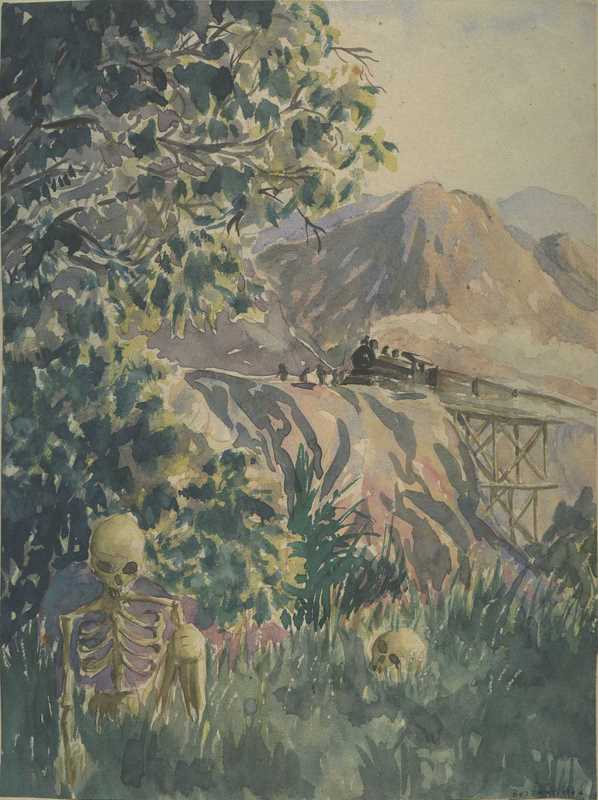Burma – Thailand Railway (Sept 1942)
 The beginnings of a macabre reputation: sketch of the Burma – Thailand railway. Did you spot the human remains in the foreground?
The beginnings of a macabre reputation: sketch of the Burma – Thailand railway. Did you spot the human remains in the foreground?
Approximately 300,000 built this 415 Km railway through jungle, over reveanes and dug by hand deep cuttings. 61,000 of these were POW’s. The death toll was high due to brutality from captors, tropical diseases, dysentery, malnutrition, and the Japanese enforcement of all to work, even the sick. 12,000 POW’s died as well as 70,000 indented Asian labourers and were largely buried where they fell.
The Japanese had troops engaged in combat with the British in Northern Burma on the border of India, with the idea of taking India from the British. They needed a reliable route to get munitions, food and troops to this area from Singapore and shipping was too dangerous due to US Submarines. The Thai Burma railway was the answer and was opened 16 Oct 1943.
“Thus, midst a welter of contradictory reports, bribery, corruption, faked sickness and genuine attempts to transfer hospital cases to better conditions, the first party – known as F Force – left Changi. It left with a large proportion of men who came direct from their beds in hospital, plus the piano, plus all sorts of paraphernalia suitable for a convalescent camp under a civilised foe.” (This was the first working party to go up country to build the Thai Burma Railway!!) ‘A short time later a second party was conscripted, H Force.”
Source: The Naked Island by Russell Braddon; 1955 edition Pan Books Ltd, Pg184
‘When we were reunited with F Force, there was no doubt that we at Changi had been to some degree deprived of necessary nourishment and it showed in our appearance, but the appearance of the survivors from F Force was such that we were absolutely shocked. They all looked like walking cadavers and gave the appearance of skeletons over which a yellowish – green skin, translucent and almost glowing, had been stretched. And these were the healthiest of the survivors. They were in good spirits at having arrived back to the comparative luxury of Changi, and told amazing stories of death and survival in the various camps along the railway.
Huge numbers had succumbed to tropical ulcers, meningitis, dysentery, dengue, malaria, fatal accidents and plain starvation. One of the major killers was cholera, and they told stories of comparatively healthy men contracting the disease and dying within twenty four hours before they eyes of their comrades. In some camps, fires were kept going twenty fours hours a day so that those who died from cholera could be burnt immediately in order to help prevent the spread of the disease.’
Source: You’ll Never Get Off The Island by Keith Wilson; 1989, Pg 89
